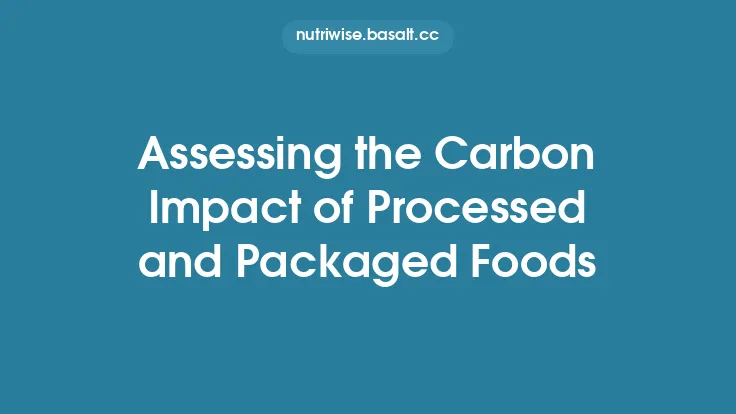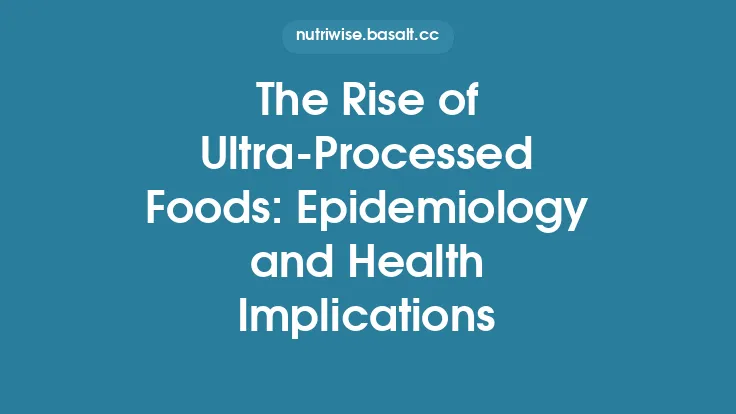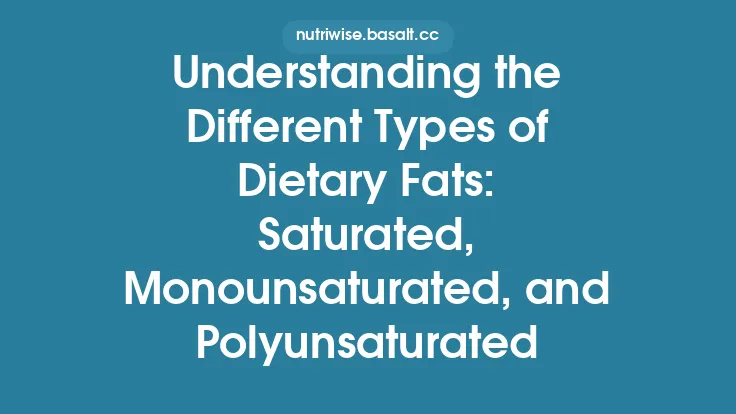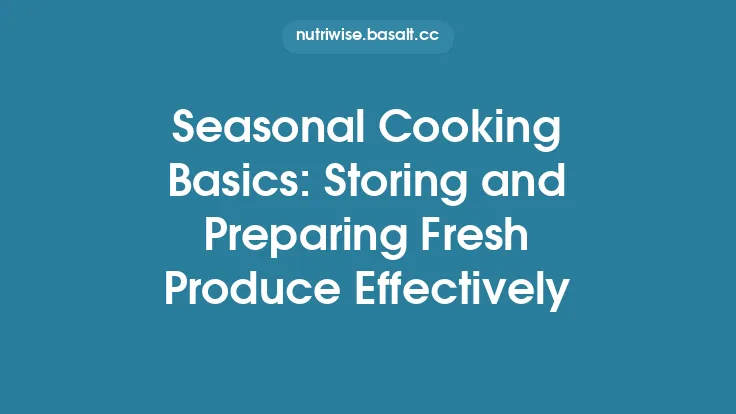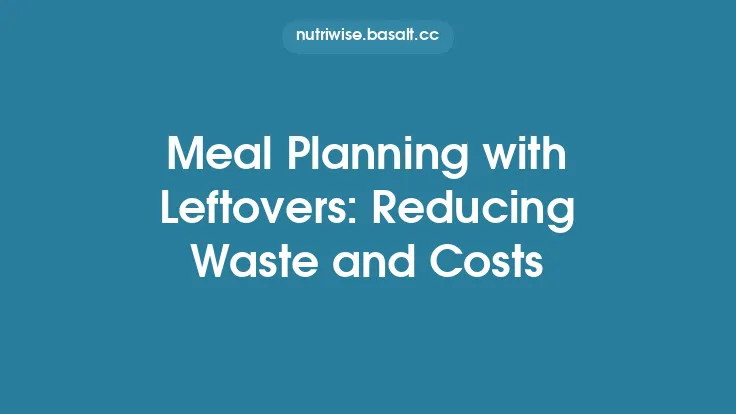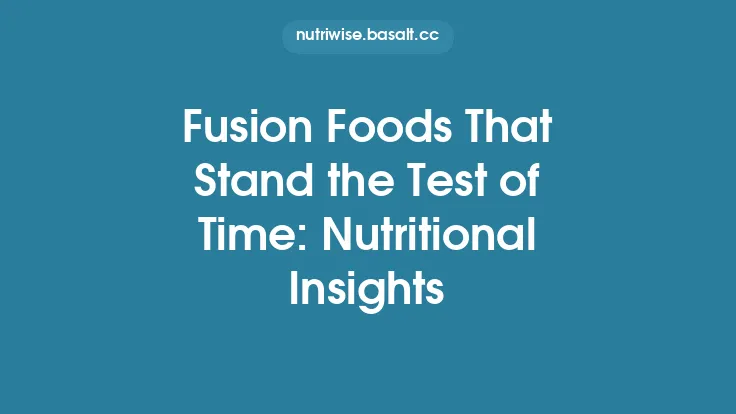Fresh foods, frozen foods, and canned foods each travel a very different path from farm to fork, and those paths carry distinct energy demands, material inputs, and waste profiles. When we speak of “carbon cost,” we are really talking about the total amount of greenhouse‑gas emissions—usually expressed as kilograms of CO₂‑equivalent (kg CO₂e)—that are released over the entire life‑cycle of a product. That life‑cycle includes raw‑material production, processing, packaging, storage, distribution, and end‑of‑life handling. By breaking the supply chain into these stages, we can see where the biggest emissions arise and why a food that looks “simpler” on the shelf (e.g., a fresh apple) may sometimes have a larger carbon footprint than a product that has been frozen or canned.
Understanding the Life‑Cycle Stages Relevant to Carbon Accounting
A robust comparison requires a common methodological framework. Most researchers rely on Life‑Cycle Assessment (LCA), which follows the ISO 14040/44 standards. The LCA is divided into four phases:
- Goal and scope definition – setting system boundaries (cradle‑to‑gate, cradle‑to‑grave, or cradle‑to‑plate) and functional units (e.g., 1 kg of edible product).
- Inventory analysis – quantifying all material and energy flows, including electricity, fuels, water, fertilizers, and packaging.
- Impact assessment – converting inventory data into climate‑change impact using global‑warming‑potential (GWP) factors for CO₂, CH₄, N₂O, etc.
- Interpretation – drawing conclusions, identifying hotspots, and testing sensitivity to assumptions (e.g., electricity mix, waste rates).
When comparing fresh, frozen, and canned foods, the functional unit is typically 1 kg of edible food at the point of consumption. This normalizes the analysis, allowing a direct carbon‑cost comparison despite differences in water content, density, or packaging weight.
Fresh Produce: Production, Harvest, and Immediate Distribution
Primary carbon sources for fresh foods are:
| Stage | Typical Emission Sources | Approx. Contribution* |
|---|---|---|
| Agricultural inputs (fertilizers, pesticides, irrigation) | N₂O from synthetic N‑fertilizer, diesel for field operations | 40–60 % |
| Harvest & post‑harvest handling | Fuel for harvest equipment, refrigeration for short‑term storage | 10–20 % |
| Packaging (cardboard, plastic films) | Production of corrugated board, PET films | 5–10 % |
| Retail refrigeration (display cases, coolers) | Electricity for chillers, often 24 h/day | 10–15 % |
| Food waste (pre‑ and post‑retail) | Emissions from discarded produce (often allocated to the product) | 5–15 % |
\*Values are ranges derived from meta‑analyses of LCA studies on fruits, vegetables, and leafy greens.
Fresh produce typically lacks intensive thermal processing, which keeps the direct energy demand low. However, the short shelf life forces a continuous cold‑chain from farm to supermarket, and any break in that chain can lead to rapid spoilage. Because a large share of the carbon cost is tied to agricultural inputs, the relative advantage of freshness depends heavily on the crop’s nitrogen demand and the efficiency of field operations.
Frozen Foods: Energy Demands of Freezing and Cold‑Chain Logistics
Freezing adds two major energy‑intensive steps:
- Blast‑freezing – rapid exposure to sub‑0 °C temperatures (often –30 °C to –40 °C) to form small ice crystals that preserve texture.
- Frozen storage & transport – maintaining temperatures at –18 °C (or lower) throughout the supply chain.
A typical LCA breakdown for frozen vegetables (e.g., peas) looks like this:
| Stage | Emission Sources | Approx. Contribution |
|---|---|---|
| Agricultural production (same as fresh) | Same as fresh | 30–45 % |
| Freezing process (industrial blast freezers) | Electricity for compressors, often high‑efficiency; sometimes natural‑gas‑fired steam for pre‑blanching | 20–30 % |
| Cold‑chain transport & storage | Refrigerated trucks, insulated containers, warehouse freezers | 15–25 % |
| Packaging (often multilayer plastic trays + cardboard) | PET, PP, EPS, cardboard | 5–10 % |
| Food waste (lower than fresh) | Reduced spoilage due to longer shelf life | 2–5 % |
Key technical points:
- Coefficient of Performance (COP) of industrial freezers typically ranges from 2.5 to 4.0, meaning that for every kilowatt‑hour (kWh) of electricity input, 2.5–4 kWh of cooling effect is delivered. Modern freezers with variable‑speed compressors can push COP above 5, substantially lowering the carbon intensity of the freezing step.
- Pre‑blanching (brief hot‑water treatment) is often required for vegetables to inactivate enzymes. This adds a short, high‑temperature steam load, but the energy is usually recovered as waste heat in integrated plants.
- Cold‑chain losses (refrigerant leakage) can be a hidden source of emissions. Hydrofluorocarbons (HFCs) have high GWP; however, the industry is transitioning to low‑GWP refrigerants (e.g., R‑290 propane, CO₂) which can cut that component by >80 %.
Overall, the additional energy for freezing raises the carbon cost relative to fresh produce, but the dramatically extended shelf life often translates into lower food‑waste emissions, partially offsetting the extra energy.
Canned Foods: Thermal Processing, Packaging, and Shelf‑Life Benefits
Canning involves three core steps:
- Thermal sterilization – heating the sealed container to 115–130 °C for a prescribed time to achieve commercial sterility.
- Metal can production – steel or tinplate manufacturing, which is energy‑intensive but benefits from high recycling rates.
- Long‑term storage – ambient temperature storage is possible for years, eliminating the need for refrigeration.
A representative LCA for canned beans illustrates the distribution of emissions:
| Stage | Emission Sources | Approx. Contribution |
|---|---|---|
| Agricultural production | Same as fresh | 25–35 % |
| Canning (thermal processing) | Natural‑gas or electricity for steam generation, water heating | 20–30 % |
| Can manufacturing | Steel production (blast furnace or electric‑arc), coating (epoxy) | 15–25 % |
| Packaging transport (to plant) | Diesel trucks (short distance) | 5–10 % |
| End‑of‑life (recycling) | Energy for metal recovery (often crediting negative emissions) | –5 % to –10 % (credit) |
| Food waste | Very low due to long shelf life | 1–3 % |
Technical considerations:
- Thermal efficiency of retort vessels (the large pressure cookers used for canning) is typically 70–80 % when using steam injection and heat‑recovery condensers. Modern “continuous‑flow” retorts can push efficiency above 85 %.
- Metal recycling is a major carbon sink. In regions where >70 % of steel cans are recycled, the net emissions from can production can be reduced by up to 1.5 kg CO₂e per kg of metal, effectively providing a negative credit in the LCA.
- Shelf stability eliminates the need for refrigeration, which is a significant advantage in regions where electricity is carbon‑intensive. The trade‑off is the higher processing temperature and the material intensity of metal cans.
Comparative Carbon Footprint: Quantitative Insights from LCA Studies
When we align the functional unit (1 kg edible product) across the three preservation methods, the median values from peer‑reviewed LCAs (e.g., *Journal of Cleaner Production, Food Chemistry*) are:
| Food type | Median carbon cost (kg CO₂e / kg edible) |
|---|---|
| Fresh (e.g., apples, lettuce) | 0.4 – 0.8 |
| Frozen (e.g., peas, berries) | 0.6 – 1.2 |
| Canned (e.g., beans, tomatoes) | 0.7 – 1.4 |
Why the ranges overlap:
- Crop‑specific factors dominate the lower bound (legumes and root vegetables have lower fertilizer needs).
- Energy mix of the region where processing occurs can shift the upper bound dramatically; a plant powered by coal will push the frozen and canned numbers higher, while a plant using renewable electricity can bring them down by 30–40 %.
- Packaging choices (e.g., glass jars vs. metal cans, or vacuum‑packed bags vs. plastic trays) add variability, especially for frozen foods where the barrier properties of the package affect freezer energy demand.
A useful visual is the “hotspot diagram” for each method, which typically shows:
- Fresh: Agriculture > Retail refrigeration > Packaging
- Frozen: Agriculture > Freezing > Cold‑chain logistics
- Canned: Agriculture > Thermal processing > Metal can production (with recycling credit)
Factors That Influence the Relative Carbon Costs
Energy Source Mix
The carbon intensity of electricity (g CO₂e /kWh) is the single most sensitive parameter. Switching a frozen‑food plant from a grid with 600 g CO₂e/kWh to one with 100 g CO₂e/kWh can cut the processing share by roughly 80 %.
Packaging Materials and End‑of‑Life Management
- Plastic trays (used for many frozen items) have a lower embodied carbon than metal cans but are less recyclable in many jurisdictions.
- Metal cans have higher upfront emissions but benefit from high recycling rates; a closed‑loop steel system can reduce the net impact by up to 50 %.
- Biodegradable or compostable films are emerging, but their production often requires additional energy and may not yet be widely recycled, so their net benefit is still under study.
Shelf Life and Food Waste Reduction
Longer shelf life directly translates into lower post‑harvest loss. Studies show that frozen vegetables can reduce waste by 30–50 % compared with fresh equivalents, while canned goods can cut waste by 60–80 % in regions lacking reliable refrigeration. The avoided waste is accounted for in LCA by allocating the emissions of the discarded portion to the remaining edible product, effectively lowering the per‑kilogram carbon cost.
Scale of Production and Technological Advances
Large‑scale plants can achieve economies of scale in heat recovery, waste‑heat utilization, and bulk refrigeration, which lower the per‑unit energy demand. Emerging technologies such as cryogenic freezing (liquid nitrogen), microwave‑assisted blanching, and high‑pressure processing (HPP) are being evaluated for their carbon‑saving potential, though many are still energy‑intensive at pilot scale.
Interpreting the Data for Consumer Choices
- Prioritize low‑waste options – If you have reliable refrigeration at home, fresh produce may be the lowest‑carbon choice for low‑input crops (e.g., leafy greens). If you lack consistent refrigeration, frozen or canned alternatives can be greener because they prevent spoilage.
- Look for packaging cues – Products that use recyclable metal cans or minimal‑plastic vacuum packs generally have a smaller end‑of‑life burden.
- Consider the source of electricity – In regions where the grid is heavily coal‑based, frozen foods processed locally may carry a higher carbon penalty. Choosing locally canned goods processed with renewable energy can offset that.
- Check the “best‑by” dates – A longer “best‑by” window often indicates a preservation method that reduces waste, which is a hidden carbon saver.
By weighing these factors, consumers can make context‑specific decisions rather than assuming that “fresh is always better” or “canned is always worse.”
Future Trends and Emerging Technologies in Low‑Carbon Food Preservation
- Renewable‑powered cold chains – Solar‑electric refrigeration units at distribution centers are already reducing the carbon intensity of frozen foods in remote areas.
- Electrified thermal processing – Induction heating and electric steam generators can replace natural‑gas boilers, cutting GHG emissions when paired with low‑carbon electricity.
- Advanced packaging polymers – Bio‑based, high‑barrier films derived from agricultural waste (e.g., cellulose nanofibrils) promise lower embodied carbon and better recyclability.
- Hybrid preservation – Combining mild blanching with high‑pressure processing can achieve sterility at lower temperatures, reducing the energy needed for canning.
- Circular metal use – Closed‑loop steel recycling, where scrap from cans is melted and re‑formed on‑site, can drive the net carbon impact of canned foods into negative territory for the packaging component.
These innovations suggest that the carbon gap between fresh, frozen, and canned foods is not static; it will evolve as the energy system decarbonizes and as manufacturers adopt more efficient technologies.
In summary, the carbon cost of a food item is a product of how it is grown, how it is preserved, and how it is packaged. Fresh produce generally has the lowest processing energy but can suffer from higher waste if the cold chain breaks. Frozen foods add a measurable energy burden for rapid freezing and refrigerated storage, yet they dramatically curb waste. Canned foods require high‑temperature sterilization and metal packaging, but their long shelf life and high recycling rates can offset those emissions, especially when the processing plant runs on clean energy.
Understanding these trade‑offs equips both consumers and producers to make evidence‑based choices that align with the broader goal of reducing the food system’s contribution to climate change.
